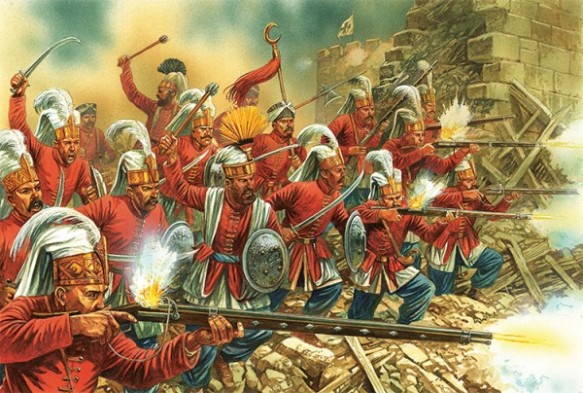Janissaries
The once prevalent idea that the Ottoman Empire entered into a period of decline after the reign of Suleyman is no longer accepted. It is perhaps preferable to view the Ottoman experience from the seventeenth to the twentieth centuries as a period of transformation during which the Ottomans struggled to find a new imperial synthesis in a changing international environment. External factors, most prominent among them the penetration of European merchant capital into the empire, caused a wrenching dislocation of the Ottoman economy. Beginning in the late sixteenth century, Ottoman raw materials, normally channeled into internal consumption and industry, were increasingly exchanged for European manufactured products. This trade benefited Ottoman merchants but led to a decline in state revenues and a shortage of raw materials for domestic consumption. As the costs of scarce materials rose, the empire suffered from inflation, and the state was unable to procure sufficient revenues to meet its expenses. Without these revenues, the institutions that supported the Ottoman system, especially the armed forces, were undermined.
The penetration of European manufactured goods into the empire and the eventual domination of Ottoman commerce by Europeans, and their protégés were facilitated by a series of commercial treaties, known as the Capitulations, which the Ottoman sultans signed with the Christian states of Europe. The first Capitulation agreement was negotiated with France in 1536. It allowed French merchants to trade freely in Ottoman ports, to be exempt from Ottoman taxes, and to import and export goods at low tariff rates. In addition, the treaty granted extraterritorial privileges to French merchants by permitting them to come under the legal jurisdiction of the French consul in Istanbul, thus making them subject to French law. The first treaty was the model for subsequent agreements signed with other European states.
The Capitulations were negotiated at a time of Ottoman military domination and were intended to encourage commercial exchange. When the military balance between Europe and the Ottomans tilted in favor of Europe, however, European merchants, backed by the power of their states, were able to exploit the Capitulations to the disadvantage of the Ottomans. The treaties not only had a devastating effect on the Ottoman economy, but they also had long-term political implications. By granting the various consuls jurisdiction over their nationals within the Ottoman Empire, the Capitulations accorded the consuls extraordinary powers that they abused with increasing frequency in the course of the nineteenth century.
External economic factors combined with a range of domestic problems, such as incompetent sultans, succession struggles, and political discord within the court, weakened the effectiveness of the central government. The shortage of revenue and the rise of inflation had a devastating effect on the large numbers of state employees on fixed salaries and created an atmosphere that fostered bribery and other forms of corruption. And finally, the government’s inability to make regular payments to the Janissaries or to fund the acquisition of new military equipment meant that the Ottoman armed forces lost the absolute dominance that they had earlier possessed.
This loss of dominance was manifested on the battlefield. In 1683, the Ottomans mounted a second siege of Vienna, but they were defeated outside the city walls. In the 1690s, the Ottomans engaged in simultaneous wars with Austria and Russia and were defeated on both fronts. The Treaty of Karlowitz, signed with Austria in 1699, ceded most of Hungary to the Hapsburgs and marked the first major surrender of European territory by the Ottomans. The next year, the sultan signed a treaty with Peter the Great acknowledging the Russian conquest of the northern shores of the Black Sea. From this point on, the Ottomans were on the defensive.
During the eighteenth century, the Ottoman forces defeated the Austrian army in two wars as well as the Russian army in two wars. These victories may have led the Ottoman ruling elite to conclude that the armed forces of the state were as relatively powerful as ever. That this was not true was demonstrated in the Ottoman-Russian war launched by the Ottomans in 1768. In the course of this war, the Russian Baltic fleet entered the Mediterranean and destroyed an Ottoman fleet off the coast of Anatolia. The land war was equally devastating for the Ottomans, as the Russian forces drove them out of Romania and the Crimea on the Black Sea. The settlement that ended the war, the Treaty of Küchük Kaynarja (1774), was one of the most humiliating agreements ever signed by the Ottomans. In addition to ceding territory, the sultan granted Russia the right to construct a Greek Orthodox Church in Istanbul and to make representations to the Ottoman government on behalf of the Greek Orthodox community. These provisions laid the foundation for Russia’s claim to be the protector of the entire Greek Orthodox millet, the Ottoman term for a self-governing religious community, within the Ottoman Empire.
